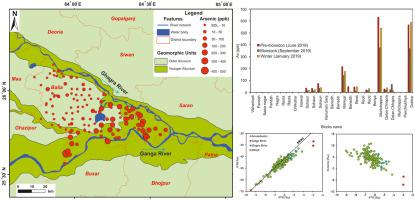Applied Geochemistry ( IF 3.1 ) Pub Date : 2021-07-06 , DOI: 10.1016/j.apgeochem.2021.105044 Sumant Kumar 1 , Suneel Kumar Joshi 1 , Neeraj Pant 1, 2 , Surjeet Singh 1 , Biswajit Chakravorty 3 , Ravi K. Saini 1 , Vinod Kumar 1 , Ankit Singh 1 , Narayan C. Ghosh 4 , Abhijit Mukherjee 5 , Prashant Rai 6 , Vijeta Singh 7

|
The present study dealt with understanding hydrogeochemical evolution, ascertaining distribution, fate and spatio-temporal variation of arsenic along with comprehending recharge processes and quantification of recharge rate in the central Gangetic plain, India. The arsenic enriched area was observed mostly in the fluvial deposits with younger alluvium. The depth to water levels maps for 1996 and 2016 showed marked spatio-temporal variation and the groundwater recharge rate was estimated to be varied between 0.05 m/year and 0.07 m/year in the study area. The elevated arsenic concentration was noticed in the region, having declined groundwater recharge. A total of 147 water samples were collected from hand pumps (n = 141) and rivers (n = 6) during the pre-monsoon period (May 2016). In addition, about 81 groundwater samples were collected from 27 locations during the pre-monsoon, monsoon and winter 2019 for studying seasonal variability in the hydrogeochemical parameters and isotopic composition of water. Arsenic concentration was found more in the area where deposits of coarser sediment of the Quaternary period was present along the rivers Ganga and Ghaghra. The arsenic concentration was observed higher in the pre-monsoon (maxm. As 641 μg/L), followed by the post-monsoon (425 μg/L) and monsoon season (375 μg/L). The depleted isotopic value and higher D-excess values in groundwater suggested active recharge conditions with precipitation as the major source of recharge in the study area. It is hypothesized that rainwater induced oxygenated water into the aquifer by the process of recharge, which may prompted various biogeochemical reactions due to change in redox conditions and endorsed arsenic sorption in the monsoon season. Thereafter, anoxic conditions prevailed in the post-monsoon season, and finally, in the pre-monsoon season, reducing conditions continued and arsenic released at a rapid rate, which was justified with the seasonal variation of arsenic concentration.
中文翻译:

印度恒河平原中部富砷区水文地球化学演化及地下水补给过程
本研究涉及了解水文地球化学演化,确定砷的分布、归宿和时空变化,以及了解印度恒河平原中部的补给过程和补给率的量化。砷富集区主要出现在冲积层较年轻的河流沉积物中。1996 年和 2016 年的深度到水位图显示出显着的时空变化,研究区的地下水补给率估计在 0.05 m/年和 0.07 m/年之间变化。该地区的砷浓度升高,地下水补给量下降。在季风前期(2016 年 5 月),从手动泵(n = 141)和河流(n = 6)中收集了总共 147 个水样。此外,在 2019 年季风前、季风和冬季期间,从 27 个地点收集了约 81 个地下水样本,用于研究水文地球化学参数和水同位素组成的季节性变化。在沿恒河和加格拉河存在第四纪较粗沉积物沉积的地区发现砷浓度更高。在季风前(最大值为 641 微克/升)中观察到砷浓度较高,其次是季风后(425 微克/升)和季风季节(375 微克/升)。地下水中枯竭的同位素值和较高的 D 过量值表明活跃的补给条件以降水为研究区的主要补给来源。假设雨水通过补给过程将含氧水引入含水层,由于氧化还原条件的变化和季风季节支持砷的吸附,这可能会引发各种生物地球化学反应。此后,季风后季节普遍缺氧,最后在季风前季节,减少条件持续,砷释放速度快,这与砷浓度的季节性变化是合理的。











































 京公网安备 11010802027423号
京公网安备 11010802027423号